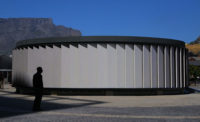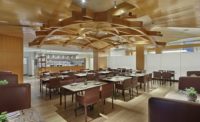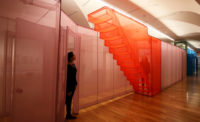Japan in Architecture: Genealogies of Its Transformation, an exhibition at the Mori Art Museum in Tokyo, is like taking the entire country and its architectural history and putting it in a nutshell—well, not exactly a nutshell, since it comprises 100 separate displays, from a 3rd-century terra-cotta model found in a burial site to the present, with an emphasis on the last 150 years since the Meiji Restoration. Much has been made over time about how Japanese architects responded to Western Modernist styles, but here the curators show how the essence of Japan’s traditional, even classical, architecture, along with vernacular forms and natural settings, maintains a presence in the most contemporary of forms, which in turn have been exported elsewhere. With an abundance of stunning models, vivid photography, informative videos, and old and new sketchbooks, this composite view is as enjoyable as it is informative—a kind of travel or, better yet, an after-having-traveled experience.
Divided into nine sections, the exhibition, which runs through September 17, appropriately begins with “Possibilities of Wood,” since the concept of kigumi, the craft of interlocking joints, is endemic to Japanese architecture. (Other sections include “Transcendent Aesthetics,” “Roofs of Tranquility,” and “Crafts as Architecture.”) Carpentry books on view with diagrams of wooden shrine roof motifs imported from China and Korea were harbored in secret until they leaked out. In the exhibition the double roof of the Great Southern Gate of Tōdai-ji in Nara (1199), with bracket arms, penetrating tie beams, and fan rafters, is juxtaposed with the long span of stacked and cantilevered wooden parts of Kengo Kuma’s 2010 Yusuhara Wooden Bridge Museum, similar in appearance.
Rooftops, curved or sharply slanted, are a distinctive feature of the Japanese landscape, whether a low roof with eaves, as seen on a full-scale replica of the 16th-century Tai-an Tea House, attributed to the tea master Sen no Rikyū, or the soaring roof with ridge poles of Kenzo Tange’s National Gymnasium for the 1964 Olympics. Captivating among these exhibits is Kazuyo Sejima’s Nishinoyama House in Kyoto, a grid of 10 sleek, small-scale, single-story rental apartments, separated by pathways and courtyard gardens, all under one roof divided into 21 pitched planes shared between the glass-walled structures.
Beyond the fixed categories, there are those iconic symbols integral to Japanese culture that have proved influential. As a high school student, Shigeru Ban saw an unforgettable inverse image of Mount Fuji reflected in nearby Lake Yamanaka. Decades later, he won the competition for the Mount Fuji World Heritage Centre with a gigantic inverted cone in latticed timber, offering views of the mountain itself.
And then there is the 1615 Katsura Imperial Villa in Kyoto, whose image is woven throughout the show, first on its own, and then in the four separate volumes of photographs by Yasuhiro Ishimoto, which capture its stark modernism. Bruno Taut, the German architect who lived in Japan in the 1930s, drew long horizontal sketches of the villa with a pink ribbon of color along the garden paths between teahouses, indicating the mountains of clipped pink azaleas in bloom on his visit, as they were just now on mine.
In a section called “Living with Nature,” the design of the Nago City Government Office in Okinawa (1981) shows special attention to the landscape by Team Zoo’s Atelier ZO (Elephant) + Atelier Mobile (Running Bird). Designed like a stack of locally inspired pergola terraces, helping to increase ventilation from sea breezes, the building is constructed of two-toned pink-andgray cinder block, a material developed for postwar construction under the occupation.
And, finally, Hiroshi Sugimoto’s retreat, Enoura Observatory, overlooking Sagami Bay, is ostensibly a strolling garden with an indoor gallery, open-air stages, a teahouse, and a Cor-Ten steel tunnel aligned with the winter solstice sunrise. By lovingly selecting rocks and gates from sacred places and combining them over a 20-year period with structures of contemporary materials, Sugimoto encapsulates the entire history of Japanese architecture and garden art. His creative process is emblematic of this entire exhibition.








Post a comment to this article
Report Abusive Comment